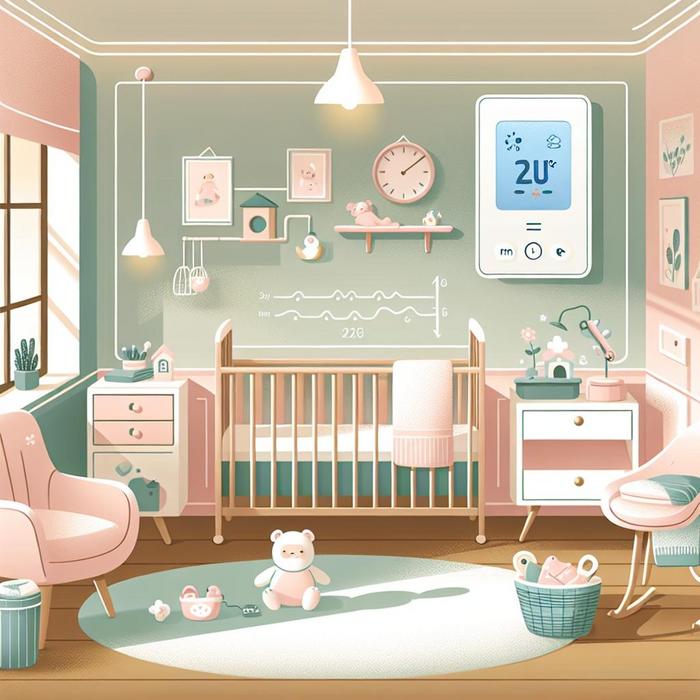The Importance of Maintaining Ideal Temperature for Baby Room
As parents, we strive to provide the utmost care for our little ones. This not only extends to their nourishment and safety but also to their surrounding environment. One significant element often overlooked is the room’s temperature. Finding the ideal temperature for a baby’s room is crucial for their comfort and health.
Why Is Room Temperature So Important?
Ensuring the correct temperature for your baby’s room contributes to their overall well-being. Fluctuations in room temperature can lead to discomfort, disrupting their sleep and even making them more susceptible to health problems. Here’s why maintaining the right temperature matters:
- Healthy Sleep: The temperature in your baby’s room impacts the quality of their sleep. When it’s too warm or too cold, the discomfort can disrupt their sleep pattern.
- Prevent Overheating: Overheating can lead to serious health issues like SIDS (Sudden Infant Death Syndrome). Keeping the room temperature in an ideal range can help prevent this.
Determining the Ideal Temperature for Baby Room
The ideal room temperature for a newborn ranges between 68 and 72 degrees Fahrenheit (20 – 22.2 Celsius). It’s important to note that every child is unique and might be comfortable within a slightly different temperature range, so monitor your child closely.
Keep in mind that room temperature isn’t the only factor that affects your baby’s comfort – humidity plays a role too. It should be kept between 30% and 60% to prevent dry skin and congestion.
How to Monitor and Adjust Your Baby’s Room Temperature
Ensuring the ideal temperature for your baby’s room can be easily achieved with a few simple steps:
- Invest in a Room Thermometer: A digital thermometer can accurately monitor the room’s temperature, ensuring it stays within the ideal range.
- Use Appropriate Bedding: The type of bedding you use can regulate your baby’s body temperature. Light, breathable fabrics such as cotton are recommended.
- Regulate Humidity: Using a humidifier can help maintain the right humidity levels, contributing to your baby’s comfort.
Adapting the Temperature for Different Seasons
Sometimes, finding the right baby room temperature can be challenging, especially during seasonal changes. However, by sticking to the recommended guidelines, dressing your baby appropriately, and using a room thermometer to monitor the temperature, you can assure your baby’s comfort and safety.
Remember, creating a comfortable environment for your baby goes beyond just the room temperature. Regular exercises like yoga can also help create a strong bond and maintain your baby’s health. Also, ensuring that your baby has comfortable soothing spaces like a swing can significantly impact their overall well-being.
Factors Influencing Room Temperature
Apart from regulating the thermostat, there are other factors that can influence the room temperature. This could include:
- Room insulation: Well-insulated rooms are better at maintaining a consistent temperature. Exterior walls, poorly insulated windows and draughts can make a room colder.
- Outdoor temperature: If it’s a cold or hot day, the outdoor temperature can also affect the indoor temperature.
- Sun exposure: Rooms that receive a lot of sunlight can be warmer than those that don’t.
Tips to Maintain the Baby’s Room Temperature
Maintaining the right room temperature for your baby’s comfort requires more than simply adjusting the thermostat. Here are a few strategies that can help:
- Block out sunlight: If the room gets plenty of sunlight during the day, consider using blackout shades or curtains to help reduce the heat.
- Use ceiling fans: A ceiling fan can circulate air, creating a breeze that helps cool the room.
- Be cautious with heaters: Never place a space heater directly near your baby or their crib. It can quickly overheat the room and pose a burn risk.
Layering Your Baby’s Clothes
Three-layer clothing can be a good rule of thumb for cold weather. Start with a short or long-sleeved onesie, add a second layer like a fleece sleep sack, and then a swaddle or blanket over the top. Of course, each baby is unique, so it’s essential to monitor signs of comfort and discomfort. Babies usually need one extra layer than adults to feel warm. On hot days, a single layer, like a lightweight onesie, will suffice.
To check your baby’s warmth, feel the back of their neck or their tummy. If these areas are warm and sweaty, your baby may be overheated. You can adjust the room’s temperature or remove a layer of clothing.
Remember that while maintaining a proper room temperature is essential, so is ensuring that your baby is comfortable in their surroundings. A comfortable baby sleep environment promotes a good night’s sleep for both of you, ensuring better health and well-being.
For more in-depth information about the right room temperature for a baby, refer to this comprehensive guide.
Conclusion
By now, you should have a better understanding of the importance of maintaining an ideal temperature in a baby’s room. It’s not just about comfort, but also about creating a conducive environment that promotes their overall health. Don’t forget to keep an eye on signs of overheating, and adjust their clothing according to the season and room’s temperature.
Like anything in parenting, it’s all about finding what works best for you and your baby. Experiment with various room temperatures and clothing options until you find the ideal solution. You could also consult a pediatrician or a baby sleep professional, if necessary.

